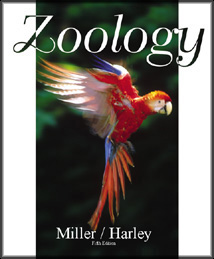 |  Zoology, 5/e Stephen A. Miller,
College of the Ozarks
John B. Harley,
Eastern Kentucky University
Ecology: Preserving the Animal Kingdom
Suggested ReadingsChapter 6 Selected Readings
BOOKS
Brewer, R. 1997. The Science of Ecology. 2nd ed. Philadelphia: Saunders College Publishing.
Hunt, C.E. 1988. Down by the River: The Impact of Federal Water Projects and Policies on Biological Diversity.
Washington, D.C.: Island Press.
Kennedy, I.R. 1988. Acid Soil and Acid Rain. Champaign, IL: Research Studies Press.
Krebs, C.J. 1993. Ecology: The Experimental Analysis of Distribution and Abundance. 4th ed. New York.
Harper ; Row.
Norton, B.G. 1988. The Preservation of Species: the Value of Biological Diversity. Princeton, Mass.: Princeton
University Press.
Wilson, E.O., ed. 1988. Biodiversity. Washington, D.C.: National Academy Press.
ARTICLES
Alley, R.B. and Bender, M.L. 1999. Greenland ice cores: frozen in time. Scientific American, February.
Ashley, M.V. 1999. Molecular conservation genetics. American Scientist, 87(1): 28-35.
Bertness, M.D. 1992. The ecology of a New England salt marsh. American Scientist 80(3): 260-68.
Bongaarts, J. 1994. Can the growing human population feed itself? Scientific American, March.
Bray, F. 1994. Agriculture for developing nations. Scientific American, July.
Brazaitis, P., Watanabe, M.E., and Amato, G. 1999. The caiman trade. Scientific American, March.
Charlson, R.J. 1994. Sulfate aerosol and climatic change. Scientific American, February.
Dasgupta, P.S. 1995. Population, poverty and the local environment. Scientific American, February.
Denny, M. 1995. Survival in the surf zone. American Scientist 83(2): 166-73.
Edmunds, P.J. 1996. Ten days under the sea. Scientific American, October.
Energy for planet earth. 1990. Scientific American, September (special issue).
Harden, G. 1986. Cultural carrying capacity: A biological approach to human problems. BioScience 36: 599-607.
Hedin, L and Likens, G 1996. Atmospheric dust and acid rain. Scientific American, December.
Herzog, H., Eliasson, B., and Kaarstad, O. 2000. Capturing greenhouse gasses. Scientific American, February.
Hoagland, W. 1995. Solar energy. Scientific American, September.
Holloway, M. 1991. Soiled shores. Scientific American, October.
Holloway, M. 1993. Sustaining the Amazon. Scientific American, July.
Holloway, M. 1994. Nuturing nature. Scientific American, April.
Jones, R.D. and Wigley, T.M.L. 1990. Warming trends. Scientific American, August.
Karl, T.R., Neville, N., and Gregory, J. 1997. The coming climate. Scientific American, May.
King, M.D. and Herring, D.D. 2000. Monitoring earth's vital signs. Scientific American, April.
Koslow, J.A. 1997. Seamounts and the ecology of deep-sea fisheries. American Scientist 85(2): 168-76.
Kusler, J.A., Mitsch, W.J., and Larson, J.S. 1994. Wetlands, Scientific American, January.
Lanham, D.A. 1995. The industrial ecology of the 21st century. Scientific American, September.
Larson, D.W., Matthes, U., and Kelly, P.E. 1999. Cliffs as natural refuges. American Scientist, 87(5): 410-417.
Lucky, R.W. 1995. What technology alone cannot do. Scientific American, September.
Mallin, M.A. 2000. Impacts of industrial animal production on rivers and estuaries. American Scientist, 88(l): 26-37.
Managing planet earth. 1989. Scientific American, September (special issue).
May, R.M. 1992. How many species inhabit the earth? Scientific American, October.
Nicol, S.J. and de la Mare, W. 1993. Ecosystem management and the Antarctic krill. American Scientist 81(l):
36-47.
Nordhaus, W.D. 1994. Expert opinion on climatic change. American Scientist 82(l): 45-51.
Norman, D.A. 1995. Designing the future. Scientific American, September.
Pauly, D., Christensen, V., Froese, R., and Palomares, M.L. 2000. Fishing down aquatic food webs. American
Scientist, 88(4): 332-339.
Pearce, D., Adger, N., Maddison, D., and Moran, D. 1995. Debt and the environment. Scientific American, June.
Peterson, D.H., Cayan, D., Dileo-Stevens,J. Nobel, M., and Dettinger, M. 1995. The role of climate in estuarine
variability. American Scientist 83(1): 58-67.
Plucknett, D.L. and Winkelman, D.L. 1995. Technology for sustainable agriculture. Scientific American,
September.
Prosterman, R.L., Hanstad, T., and Ping, L. 1996. Can China feed itself? Scientific American, November.
Repetto, R. 1990. Deforestation in the tropics. Scientific American, April.
Robison, B.H. 1995. Light in the ocean's midwaters. Scientific American, July.
Romme, W.H. and Despain, D.G. 1989. The Yellowstone fires. Scientific American, November.
Rutzler, K. and Feller, I.C. 1996 Caribbean mangrove swamps. Scientific American, March.
Sanderson, J.G. 2000. Testing ecological patterns. American Scientist, 88(4): 332-339.
Schneider, D. 1997. The rising seas. Scientific American, March.
Scott, J.M., Csuti, B., Jacobi. J.D., and Estes, J.E. 1987. Species richness: A geographic approach to protecting
future biological diversity. BioScience 37: 782-788.
Terborgh, J. 1992. Why American songbirds are vanishing. Scientific American, May.
Trivers, R.L. 1971. The evolution of reciprocal altruism. Quarterly Review Biology 46: 35.
Vitousek, P.M., D'Antonio, C.M., Loope, L.L., and Westbrooks, R. 1996. Biological invasions as global
environment changes. American Scientist, 84(5): 468-478. |
|



 2002 McGraw-Hill Higher Education
2002 McGraw-Hill Higher Education